I
like to tell stories with images, some based on truth, some fictitious.
I play cache-cache, a process of hide and
seek, to delight the viewer with visual surprises, as well as
to instruct. My pictures, drawings and other works are unrealistic
representations
with a quality that is almost hallucinatory. I treat the landscape,
architecture or figure schematically, devoid of atmosphere in
real time, seemingly impelled by some hidden source. I do not
arrive at
this effect casually. I use conventional images in an unorthodox
way to achieve effects of unreality so that a sense of urgency
is conveyed to the view - this is not slavish illustration -
for I disassemble
and rearrange the elements of my story in a sophisticated technique
that chooses visual ideas which will most enhance my representation.
Characteristic
of our century, originality is often expressed as freakishness
and constant change is thought to express originality.
I have "leapt from one unique style to another",
often changing from one media, such as painting, to tapestry
weaving or
sculpture, in order to tell stories that cannot be analyzed
or explained logically. What matters to me is the subconscious
message, for I
believe that, if a work of art needs to be explained, then
it probably is not a work of importance, and what I prefer
to do is to 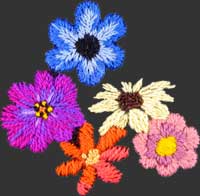 infuse
new life into very old symbols to bring to the future ideas
that are relevant to it without sacrificing the past. I often
use themes
from legend or scripture as a spring-board for the transfer
of archetypal information which is essentially non-logical
and appeals to the feelings
and intuitions. Sometimes I simply report what I see.
infuse
new life into very old symbols to bring to the future ideas
that are relevant to it without sacrificing the past. I often
use themes
from legend or scripture as a spring-board for the transfer
of archetypal information which is essentially non-logical
and appeals to the feelings
and intuitions. Sometimes I simply report what I see.
There
are two realities. The first is Physical material reality, which
is perceived by the body. The second is the Immaterial
or psychic reality, which is perceived in the mind only.
We have then, Concrete
reality and Immaterial reality. A work of art can give one
the appearance of the other. It is able to associate them
and blend them.
Marcel
Marceau, the famous French mime, said, in an interview, "A
work of art can prove nothing in fact, but it touches the soul profoundly".
We
respond to this profundity when it is genuine in any artistic
performance; visual, oral, physical or tactile.
It also includes
Architecture and both Prose and Poetry, in their written
form. What follows is my perception of the visual art
process in
drawing, painting,
sculpture and fiber, which I know best through my own
experience.
I
preface this with a thought or two from Thomas F. Mathews, art
historian, in his book "Clash of the Gods". This is
a story of the displacement of the ancient Greek and Roman pantheon
with
the impact of Christianity and, in particular, images
of Christ.
He
writes about portraiture. Images of Socrates, Plato and other
philosophers were done while these men were
still alive
or just recently
dead, and were described by those who knew them and
are probably accurate images. He then remarks that
there
is no contemporary
description of Jesus. Images of him are pure 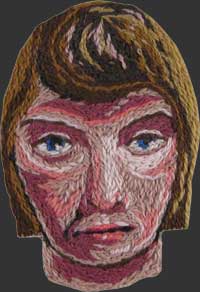 projections
in the psychological
sense. That is, inventions corresponding to what
people need or want from him. The enormous variety of images
of him are
the immediate
consequence of this. But, once "imaged",
Jesus becomes what people picture him to be.
projections
in the psychological
sense. That is, inventions corresponding to what
people need or want from him. The enormous variety of images
of him are
the immediate
consequence of this. But, once "imaged",
Jesus becomes what people picture him to be.
Images
are dangerous. Images are not neutral; they are not just stories
put into pictures. Images, no
matter
how discreetly
chosen, come
freighted with conscious or subliminal memories,
no matter how limited their use. Often images overwhelm
the ideas
that they are supposed
to be carrying or dress up, with respectability,
ideas
that in themselves are too shoddy to carry intellectual
weight.
Images not only express
convictions, they alter feelings and end up justifying
these convictions. Eventually, they, of course,
invite worship.
One cannot write history
without dealing with the history of images, and
of no epoch is this truer than the fourth and fifth
centuries (and
it also can be said
of our current era, with the plethora of visual
images justifying the most puerile and frivolous ideas,
in a
manner that justifies
them as a way of life). The Torah and the Koran
forbid images of God.
Visual
art, however, is abstract. In actual fact, the brain stores our
visual impressions in abstract
impulses,
often
in different parts
of the cerebellum. (Even in brain damage, we
may not lose total visual memory). We quite literally
see with
the brain,
not
the eyes. Image
making is a right-brained activity and the artist
often induces the "Alpha
State" when doing this art. Time slips away
along with other activities such as hearing or
eating. Often if the process is interrupted,
it is very difficult to recover the feeling which
produced these images.
One
should remember then, that in a drawing or painting as examples,
we reduce the three dimensional
world
that we perceive
as reality
onto a two-dimensional plane on paper or canvas.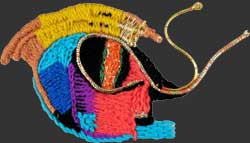 This is true of total optical realism as well as the most
stringent
abstract
image.
Some contemporary physicists even suggest that
this total optical reality may be an illusion
and that
the abstract
image may
be closer to the correct one.
This is true of total optical realism as well as the most
stringent
abstract
image.
Some contemporary physicists even suggest that
this total optical reality may be an illusion
and that
the abstract
image may
be closer to the correct one.
Over
the centuries, many cultures have developed interesting conventions
to depict the two realities.
Much of it
abstracted into simple images
of the natural or supernatural world. Importance
was indicated by size. The king was bigger
than his subjects.
(Young
children still
do this; the dominant adult is drawn bigger
than the lesser folk). These abstract images
indicate
to the
viewer how
one should feel
towards them and are psychic realities rather
than objective observation.
For
about four thousand years, the Egyptians used a system of stylized
image-making to
depict the
human figure.
The head was shown in profile
with the eye delineated as viewed from
the front. The
shoulders, too, were frontal but the arm
and hands were often seen
in profile. The feet were turned in profile
to best show the
foot. (Try drawing
a foot from the front view and understanding
will dawn). Their sculpture did not do
this. It showed
the figure
as it is, in
the round, but
very stiffly erect staring straight ahead
without any turning to left or right, whether
sitting
or standing.
The queen
was often much
smaller, only as high as the calf of the
Pharaoh's leg, indicating her lesser position.
The
Greeks started with this method of depicting the figure, both
in painting
and in sculpture,
but they
soon began
to give the figure
a feeling of movement and action. The
Greek's styles were first archaic (as the Egyptians)
then became
more realistic
but still
simple, in
carving or painting. During the golden
age of Pericles, usually referred to
as Classic,
much
more realism
was evident, full
of fluttering
fabric and pose, but the style was still
restrained and refined. Finally, during
Alexander's time,
images of
humans became
full of overblown operatic movement,
with much unrestrained emotion
yet done
with great technical skill. (The Greek
word for art, "Technos"
actually means "skill"). Most
styles of Western art followed this pattern
of development: first, archaic, then
accomplished, followed
by classic and finally decadent/romantic.
With each new style (including modern
art), we observe this pattern repeating
itself.
In
oriental art, in Japan, China and India, distance was suggested
by placing
things
higher in the
picture plane
(the rectangle
enclosing the design). Most of their
sculpture, though handled realistically,
was of dragons or other mythical animals,
spirits or gods that exist in the mind
of the believer.
Often the tree,
the mountain,
water
and the tiny human figure were included
in a landscape design. Many ritual
designs, such as
the mandala,
have
a circular
center divided
into four parts and surrounded or 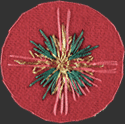 enclosed
by a series of linear squares. They
were used in
Hindu
and Buddhist
ritual
and depicted
psychological reality. They are considered
to have healing power or to connect
with or evoke
spiritual
power. These
are often destroyed
after completion to prevent contamination
or to send the “good
karma” into the world. The Native
Americans have a similar ritual when
doing sand paintings and ritual dances
all for healing
purposes, which are destroyed at the
finish of the ceremony.
enclosed
by a series of linear squares. They
were used in
Hindu
and Buddhist
ritual
and depicted
psychological reality. They are considered
to have healing power or to connect
with or evoke
spiritual
power. These
are often destroyed
after completion to prevent contamination
or to send the “good
karma” into the world. The Native
Americans have a similar ritual when
doing sand paintings and ritual dances
all for healing
purposes, which are destroyed at the
finish of the ceremony.
In
the medieval world, many conventions
suggested psychic reality. Gold leaf
backgrounds indicated
that the event
was taking place
out of earthly reality in another
world of heavenly space. Holy or saintly
folk (in many cultures) were indicated
by the use of a halo, often golden.
In Christian
art,
a circular
halo indicated
New Testament
characters and a square or triangular
one for Old Testament
folk. Mary and Jesus were often totally
enclosed in an almond
shaped (mandorla)
halo, radiating golden rays of light.
Very specific colors were used for
various objects
and clothing
to indicate
identity to an illiterate
public in order that they would know
who was whom in each work of art.
Perspective,
though used by the Romans, was forgotten and was rediscovered
in the late
Gothic age again
and re-entered
works
of Western art.
Developed by Giotto in Italy in
the
early Renaissance, it has come
to dominate western art for centuries.
It was not
until
the advent
of Japanese prints and African
masks into Europe in the late 1800s, that
abstract
images began
again to
be a
style generating
phenomena
for professional artists. Folk
art retained the older non-perspective
ways much longer.
Some,
even now,
are the dominant images
of many cultures. In the 1800s,
the Pre-Raphaelites and the Arts
and Crafts
movement, both in Europe and in
America, revived much of the medieval and
folk
tradition.
The
impressionists were
interested
in light and
often abandoned the classical approaches
that were still taught in the official
schools. They were
not interested
in total
optical observation,
however, and stressed the momentary
effects of light. The invention
of the camera
put portrait
painting
out
of business
for most
artists and has had a lot of influence
in the present pre-occupation with
realism. Much contemporary work
is based on slavish
translations of camera images into
digital images and onto canvas
for a few additional daubs by the
artist, and has even been
utilized in polychrome works
of sculpture. This literalism is
appealing to a certain mind-set
and in my estimation
amounts
to "busy work." (It is clever,
but is it art?). In addition, it only approximates a reality caught
in a single moment of time. In a certain sense, it lacks "soul".
It does not speak in archetypal
images. Interestingly, many so-called
primitive peoples depict images
of animals and humans in their
totality; both their insides and
their outside, in a single image.
Examples
being Australian aboriginal art
or the art of the Native Americans,
especially those who lived on the
northwest coast.
Children
do not understand perspective
and, at first, depict objects
as they know them
to be
when they
draw or paint.
A chair has four
legs of the same length. It sets
on the floor which is the bottom
of the
paper.
The sun
is in the sky
at the
top of
the paper. We can
trace the evolution of man's
visual imagery through child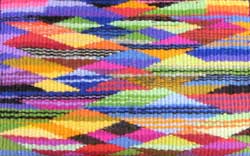 art. Their
spontaneous art production follows
the history
of image-making
since
earliest times. This image-making
often
stops and is abandoned with the
advent of puberty
and the "I can't draw" syndrome.
At this time, starting about
age twelve, total optical depiction
of ideas seems to them the only
way to produce images, which
they cannot do easily, so art
is abandoned. Often these same
young people
can be lead back to art production
through other media such as the
fiber arts or ceramics, for self-expression,
which then stimulates image-making
again.
art. Their
spontaneous art production follows
the history
of image-making
since
earliest times. This image-making
often
stops and is abandoned with the
advent of puberty
and the "I can't draw" syndrome.
At this time, starting about
age twelve, total optical depiction
of ideas seems to them the only
way to produce images, which
they cannot do easily, so art
is abandoned. Often these same
young people
can be lead back to art production
through other media such as the
fiber arts or ceramics, for self-expression,
which then stimulates image-making
again.
The
many that do continue without faltering are perhaps able to
hold onto childhood
longer. Often,
mature
artists are
quite child-like,
especially in their delight
at image-making. Intuition is such
an important ingredient
in art that many
artists cannot
explain
how
they produce their work or
what it means.
Having
observed all these facts, the abstract image, then, is
just as legitimate
a form
of expression
as is a realistic
image. Working
in the abstract forces attention
to color choices, shapes,
lines and proportions
(that can be
harmonious or not),
to create moods,
feelings and sensations that
are not scientific fact-finding
or,
perhaps, to depict far-out
theory in physics
that is not yet provable.
Brushwork or other surface
techniques can express movement
or texture.
Surfaces
do
not have to
be on a single
flat plane but can move in
other directions. This is
especially true of mosaic work where light
can be
reflected
in
new ways by
moving the
light source
as the image
is viewed or setting the
small tessere (tiles) at different
angles to the
viewer.
Art
and image-making is a process of self-discovery
for both
the artist and the viewer.
It
leads one to new concepts
of
reality or
spirituality. It is a journey.
It is
a vital and often overlooked
part of our
social fabric,
particularly
here in America.
It can express, in images,
what written words cannot.
It can
have social impact and
immediacy. The viewer is
as much a participant as
the
artist. It is a partnership,
an adventure.
It defines our community,
our culture,
and our world. It can celebrate
the past, the present,
or the future. (Some physicists
believe
these three
co-exist). It
communicates in
a language that is universally
understood.
We
say that art works are creative, often relying
on intuition
as opposed to scientific
fact-finding.
But,
creativity
is meaningless without
discipline. Scientific
discipline without
creativity
is equally
meaningless. Art is all
that survives most previous
civilizations.
Their
technical and scientific
achievements are usually
lost and have to be rediscovered.
The techniques
that produced this surviving
art also have to be rediscovered.
We seem to have to rediscover
the wheel
over and
over
again.
Postscriptum:
Carl
Jung, the late Swiss Psychologist, put forward
the concept of "archetype",
in that he felt that certain images occur over and over in many
cultures, through many decades; that these have a meaning that
is understood
intuitively rather than through rational deduction. Dreams and
works of art contain hundreds of such symbolic thought forms.
A sign points
a direction, an archetypal symbol stands for something else and
is a metaphor. Much of what I understand of my own "visual
dream" artworks
is the result of reading the collected works of this wunderkind.
I discovered him in the late 50's and corresponded with one of
his associates, Dr. Jolanda Jacobi, for many months. I began
to understand
what an artist is really doing.
E.
Thor Carlson,
Newport, New Hampshire, 2007
